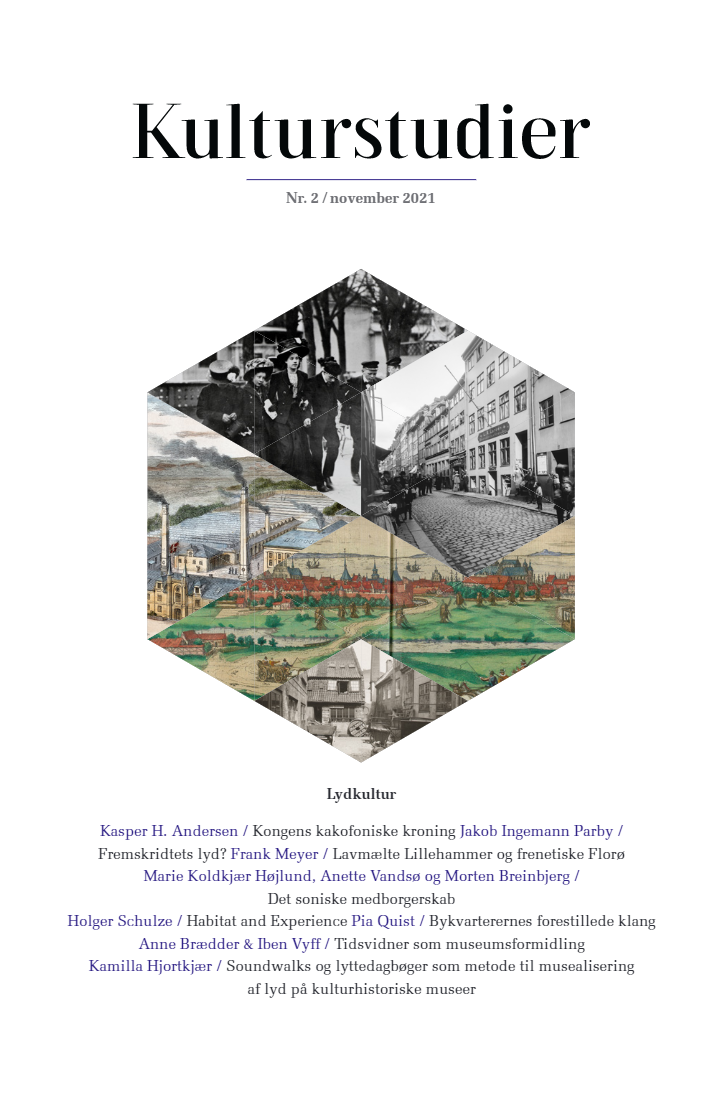Habitat and Experience
An Anthropology of the Sonic Agglomeration
DOI:
https://doi.org/10.7146/ks.v12i2.129570Nøgleord:
sound studies, anthropology of sound, urban studies, soundwalk, psychogeography, rhythmanalysis, sound design, podcast, 2020s, CopenhagenResumé
This contribution provides a contemporary introduction into research and artistic practices related to the study of sonic agglomerations from the perspective of an anthropology of sound. The article has four parts within which its author traverses and experiences an agglomeration such as Copenhagen by employing the very methods, practices and explorative approaches that are introduced in this article. Starting with “Spatial Volumes, Secluded and Eroding“ (part 1), the author focuses then on “Protocol and Dérive“ (part 2), „The Noise of the Other“ (part 3), “An Escape to Recreate” (part 4) and asks toward the end the question “What Might a City Be?” In this way the urban sonic experience is unfolded through recent research approaches within or close to the field of sound studies.
Referencer
Altman, Rick 1992 (red.): Sound Theory, Sound Practice. Routledge Publishers.
Auinger, Sam and Offenhuber, Dietmar 2021: „The Plaza,“ Holger Schulze (red.): The Bloomsbury Handbook of the Anthropology of Sound. Bloomsbury Academic, s. 191-209.
Venäläinen, Juhana, Pöllänen, Sonja and Muršic, Rajko 2021: „The Street,“ Holger Schulze (red.): The Bloomsbury Handbook of the Anthropology of Sound. Bloomsbury Academic, s. 225-240.
Bachelard, Gaston 2000 (1936): The Dialectics of Duration. Translated and annotated by Mary McAllester Jones. Introduction by Christina Chimisso. Clinamen Press
Bachelard, Gaston 1994 (1958): The Poetics of Space. Translated from the French by Maria Jolas, Beacon Press.
Bijsterveld, Karin 2008: Mechanical Sound. Technology, Culture and Public Problems of Noise in the Twentieth Century. MIT Press.
Bijsterveld, Karin 2018: Sonic Skills. Listening for Knowledge in Science, Medicine and Engineering, 1920s-Present. Palgrave Macmillan.
Bijsterveld, Karin and Cleophas, Eefje 2012: “Selling Sound: Testing, Designing, and Marketing Sound in the European Car Industry,” Karin Bijsterveld and Trevor Pinch (reds.), The Oxford Handbook of Sound Studies, 102–124. Oxford University Press.
Bijsterveld, Karin, Cleophas, Eefje, Krebs, Stefan and Mom, Gijs 2014: Sound and Safe. A History of Listening behind the Wheel. Oxford University Press.
Béarn, Pierre 1951: Couleurs d’usine. Seghers. Blesser, Barry and Salter, Linda-Ruth 2007: Spaces Speak, Are You Listening? Experiencing Aural Architecture. MIT-Press.
Brighenti, Andrea Mubi and Kärrholm, Matthias 2018: „Beyond rhythmanalysis: towards a territoriology of rhythms and melodies in everyday spatial activities“. City, Territory and Architecture: An interdisciplinary debate on project perspectives 5 (4) (2018). https://doi.org/10.1186/s40410-018-0080-x
Bull, Michael 2018 (red.): The Routledge Companion to Sound Studies. Routledge Publishing.
Bull, Michael and Cobussen, Marcel 2021 (red.): Sonic Methodologies. Bloomsbury Academic.
Collins, Karen 2020: Studying Sound. A Theory and Practice of Sound Design. MIT-Press.
Debord, Guy 1956: „Theory of the Dérive“ Les Lèvres Nues #9 (November 1956) Translated by Ken Knabb.
Dru, Jean-Marie 1996. Disruption : Overturning Conventions and Shaking Up the Marketplace, John Wiley & Sons, 1996.
Eidsheim, Nina 2019: The Race of Sound. Listening, Timbre & Vocality. Duke University Press.
Fisher, Mark 2009: Capitalist Realism. Is There no Alternative? Zero Books.
Godfathers, The 1988: „Birth School Work Death“ The Godfathers: Birth School Work Death. Epic, track 1.
Goodman, Steve 2009: Sonic Warfare: Sound, Affect, and the Ecology of Fear. MIT-Press.
Graeber, David 2004: Fragments of an Anarchist Anthropology. Prickly Paradigm Press.
Groth, Sanne Krogh & Mansell, James 2021 (red.): Negotiating Noise: Across Places, Spaces and Disciplines. Publications from the Sound Environment Centre at Lund University, Number 19.
Klein, Naomi 2007. The Shock Doctrine: The Rise of Disaster Capitalism. Knopf Canada.
Kracauer, Siegfried 1930: Die Angestellten. Aus dem neuesten Deutschland. Societäts-Verlag.
Lefebvre, Henri 2004 (1992): Elements of rhythmanalysis: an introduction to the understanding of rhythms. Continuum.
Lefebvre, Henri and Regulier Catherine 1985: „Le projet rythmanalytique“ Communications 41, 1985, s. 191-199.
Maier, Carla 2020: Transcultural Sound Practices: South Asian Dance Music as Cultural Transformation. Bloomsbury Academic.
Maier, Carla and Van Drie, Melissa 2022 (under review): Rhythming: Sensory Modes and Performative Acts of Sonic Thinking Sound Studies 8, no. 1, 2022.
Morton, Timothy 2013: Hyperobjects: Philosophy and Ecology After the End of the World. University of Minnesota Press.
Pinheirodos Santos, Lúcio Alberto 1931: „La Rhythmanalyse“ Société de psychologie et de philosophie, Rio de Janeiro.
Revol, Claire 2019: „Henri Lefebvre’s rhythmanalysis as a form of urban poetics“ Michael E. Leary-Owhin and John P. McCarthy (red.): The Routledge Handbook of Henri Lefebvre, the City and Urban Society. Routledge Publishers, s. 173-182.
Robinson, Dylan 2020: Hungry Listening. Resonant Theory for Indigenous Sound Studies. University of Minnesota Press.
Schafer, R. Murray 1993: The Soundscape: Our Sonic Environment and the Tuning of the World. Simon and Schuster.
Schulze, Holger 2022 (in print): “Sonischer Materialismus. Klang als materialer Eingriff in Who Taught You To Be White von Phoebe Unter/The Heart“ Nils Lehnert, Ina Schenker and Andreas Wicke (reds.), Gehörte Geschichten. Phänomene des Auditiven. Walter de Gruyter.
Schulze, Holger 2021 (red.): Bloomsbury Handbook of the Anthropology of Sound. Bloomsbury Academic.
Schulze, Holger 2018: The Sonic Persona. An Anthropology of Sound. Bloomsbury Academic.
Schumpeter, Joseph A. 1994 (1942): Capitalism, Socialism and Democracy. Routledge Publishers.
Steingo, Gavin and Skyes, Jim 2020: Remapping Sound Studies. Duke University Press.
Sterne, Jonathan 2003: The Audible Past: Cultural Origins of Sound Reproduction. Duke University Press.
Thompson, Emily 2002: Soundscape of Modernity: Architectural Acoustics and the Culture of Listening in America, 1900–1933. MIT-Press.
Thompson, Marie 2017: Beyond Unwanted Sound: Noise, Affect and Aesthetic Moralism. Bloomsbury Academic.
Unter, Phoebe 2020: Race Traitor. The Heart Radio 2020. Online: https://www.theheartradio.org/race-traitor/2020/5/5/who-taught-you-to-be-white-1-of-4
Wark, McKenzie 2011: The Beach Beneath the Street: The Everyday Life and Glorious Times of the Situationist International. Verso Books.
Westerkamp, Hildegard 1989: “Kits Beach Soundwalk.” Hildegard Westerkamp. Transformations. empreintes DIGITALes, track 3.
Woolf, Virginia 2018 (1929): A Room of One’s Own. Penguin Random House.
Yusoff, Kathryn 2018: One Billion Black Anthropocenes or None. University of Minnesota Press.
Zuboff, Shoshana 2019: The Age of Surveillance Capitalism: The Fight for a Human Future at the New Frontier of Power. Profile Books
Downloads
Publiceret
Citation/Eksport
Nummer
Sektion
Licens
Tidsskriftet forbeholder sig ret til førsteudgivelsen, mens ophavsretten til artiklen tilfalder forfatteren.
Artikler udgivet af Kulturstudier licenseret under en Creative Commons Navngivelse-IkkeKommerciel-IngenBearbejdelse 4.0 International Licens





